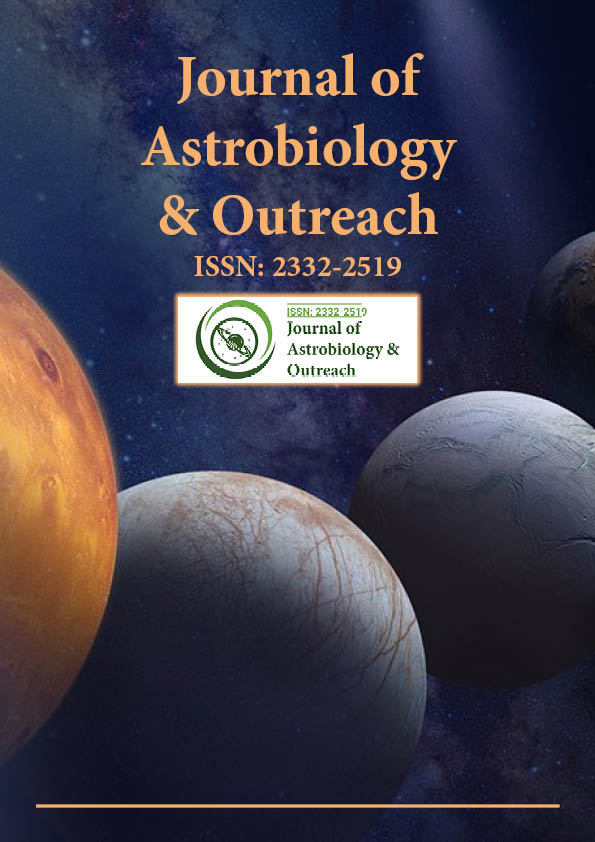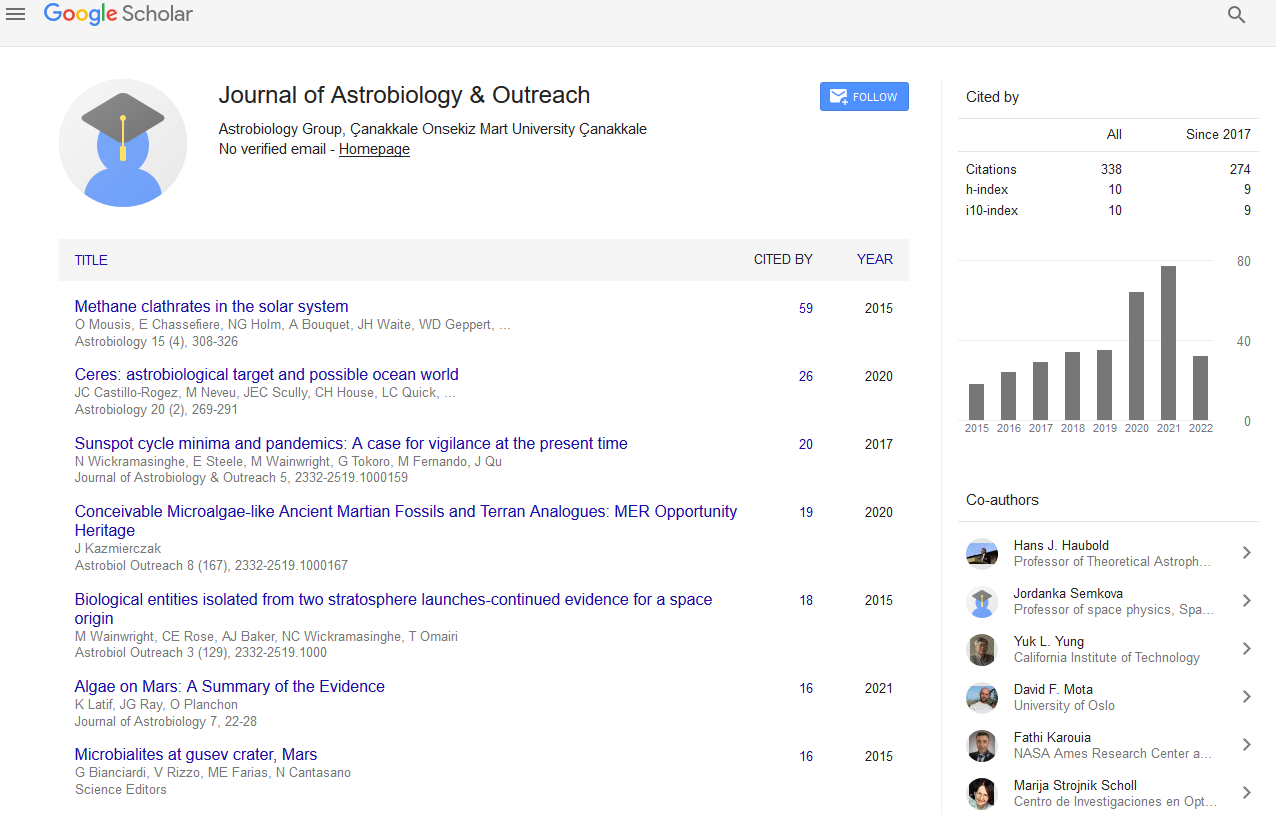Indexed In
- Open J Gate
- Academic Keys
- JournalTOCs
- RefSeek
- Hamdard University
- EBSCO A-Z
- OCLC- WorldCat
- Google Scholar
Useful Links
Share This Page
Journal Flyer

Open Access Journals
- Agri and Aquaculture
- Biochemistry
- Bioinformatics & Systems Biology
- Business & Management
- Chemistry
- Clinical Sciences
- Engineering
- Food & Nutrition
- General Science
- Genetics & Molecular Biology
- Immunology & Microbiology
- Medical Sciences
- Neuroscience & Psychology
- Nursing & Health Care
- Pharmaceutical Sciences
Opinion Article - (2024) Volume 12, Issue 4
Advancing the Search for Technosignatures: The Role of Future Space Missions in Detecting Intelligent Life
Mariana González*Received: 29-Nov-2024, Manuscript No. JAO-24-28016; Editor assigned: 02-Dec-2024, Pre QC No. JAO-24-28016 (PQ); Reviewed: 16-Dec-2024, QC No. JAO-24-28016; Revised: 23-Dec-2024, Manuscript No. JAO-24-28016 (R); Published: 30-Dec-2024, DOI: 10.35248/2332-2519.24.12.367
Description
The Search for Extraterrestrial Intelligence (SETI) has long been one of human civilization's most significant searches, guided by the desire to understand whether we are alone in the universe. While the search for biological signs of life, such as microbial life on Mars or the moons of Jupiter and Saturn, has received substantial attention, the search for Technosignatures-the potential evidence of advanced technological civilizations-has gained increasing prominence in recent years. Technosignatures are signs of technological activity that could be detected remotely, providing insights into the existence of intelligent life beyond Earth. As space describes technologies advance and our understanding of the universe expands, the development of new mission concepts to search for Technosignatures becomes not only possible but also essential for the future of astrobiology.
Technosignatures can take many forms, ranging from radio signals to megastructures and may be detectable using a variety of instruments. One of the primary goals of future missions focused on Technosignatures is to identify signals or objects that cannot be easily explained by natural phenomena. Radio waves, for example, are a common avenue for SETI research, with efforts like the Search for Extraterrestrial Intelligence (SETI) at the green bank telescope aiming to detect artificial radio signals from distant star systems. In addition to radio signals, researchers are increasingly considering other potential Technosignatures, including laser emissions, electromagnetic pollution and even the detection of massive artificial structures like Dyson spheres. The discovery of such signatures would fundamentally transform our understanding of the universe, confirming the existence of technologically advanced civilizations beyond Earth.
One of the most exciting concepts for future missions to search for Technosignatures involves the use of advanced space telescopes. Instruments capable of directly observing varied exoplanets and their environments are critical for identifying potential biosignatures and Technosignatures. The James Webb Space Telescope (JWST), scheduled for launch in the coming years, is set to be a powerful tool for investigating the atmospheres of exoplanets. However, to focus specifically on Technosignatures, future telescopes would need to go beyond the capabilities of JWST by incorporating specialized instruments designed to detect artificial signals. Concepts such as the Habitable Exoplanet Imaging Mission (HabEx) or the Large Ultraviolet/Optical/Infrared Surveyor (LUVOIR) are under consideration, which aims to provide innovative resolution and sensitivity in detecting faint emissions from different worlds.
In particular, the search for Technosignatures could be significantly improved by missions that explain both the electromagnetic spectrum and novel detection methods. For example, optical and infrared signals may be used to detect laser emissions, which could be indicative of communication systems or power generation technologies discovered by extraterrestrial civilizations. A space telescope designed to detect such signals could observe remote star systems for anomalous pulses of light, which might suggest the presence of artificial sources, such as massive lasers or communications between advanced civilizations. Similarly, missions designed to detect microwave signals in the search for large-scale transmitters or transmitters with specific modulation patterns could reveal technologically advanced societies.
The potential discovery of Technosignatures would have significant consequences for the search for extraterrestrial life. Beyond confirming the existence of intelligent civilizations, the detection of Technosignatures could revealed on the technological capabilities of other civilizations, providing valuable insights into their development, energy utilization and potentially even their longevity. The search for Technosignatures would also provide a momentum for collaboration between disciplines, including astrophysics, engineering and philosophy, as we collectively seek to understand our place in the universe and the possibility of intelligent life beyond Earth.
In conclusion, the search for Technosignatures is an exciting and evolving frontier in the field of astrobiology and space exploration. As our technological capabilities continue to improve, future missions to detect these signals will likely incorporate a wide range of innovative methods, from advanced telescopes to interstellar describes. By pushing the boundaries of our observational technologies and utilizing novel detection techniques, we stand on the edge of a new era of exploration that could answer one of human civilization's most significant questions: Are we alone in the universe? As we develop and refine concepts for these missions, the search for Technosignatures will not only advance our understanding of the cosmos but also lay the foundation for the next great discovery in the search for extraterrestrial intelligence.
Citation: González M (2024). Advancing the Search for Technosignatures: The Role of Future Space Missions in Detecting Intelligent Life. J Astrobiol Outreach. 12:367.
Copyright: © 2024 González M. This is an open-access article distributed under the terms of the Creative Commons Attribution License, which permits unrestricted use, distribution, and reproduction in any medium, provided the original author and source are credited.

